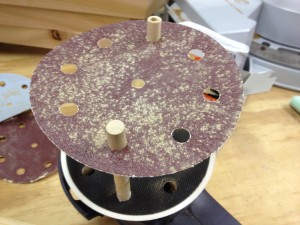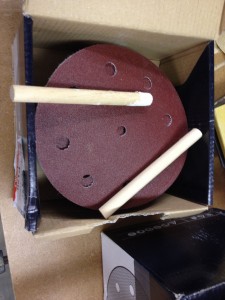No Southern-fried Southern boy wants to be called a Yankee, but we share the characteristics of shrewdness and thrift. Thus, each month we include a money-saving tip. It’s OK if you call me “cheap.”
Wooden handles for foam paintbrushes have lots of uses, and we’ve extolled those uses before. Click here to revisit that post. Here is one more. When the foam part of the brush has given its all, and the plastic “blade” is broken off, if the wooden part is 3/8” diameter, it makes a great guide for installing new sanding discs on your random orbit sander’s pad. The 3/8” size “dowel” is a tight fit in the holes of the sanding pad. Put a stick in the diagonally-opposite sides of the pad and slide the new disc down and into place.

YOU PAID WHAT? These 3/8″ dowels were free, salvaged from many-times-reused “disposable” sponge finish applicators. The snug fit means your hole alignment will be perfect. Just slide the loops down to the hooks.
You will have perfect alignment for the dust extractor to remove the maximum amount of swarf as you work. I like to keep two dowels in each grit of sandpaper. That way, no matter which sander I’m using, the alignment devices will be handy.

Two brush handles in each grit of sanding discs means quick, easy (and, did I mention free?) alignment.
—-
Jim Randolph is a veterinarian in Long Beach, Mississippi. His earlier careers as lawn mower, dairy farmer, automobile mechanic, microwave communications electronics instructor and journeyman carpenter all influence his approach to woodworking. His favorite projects are furniture built for his wife, Brenda, and for their children and grandchildren. His and Brenda’s home, nicknamed Sticks-In-The-Mud, is built on pilings (sticks) near the wetlands (mud) on a bayou off Jourdan River. His shop is in the lower level of their home. Questions and comments on woodworking may be written below in the comments section. Questions about pet care should be directed to his blog on pet care, www.MyPetsDoctor.com. We regret that, because of high volume, not all inquiries can be answered personally.

